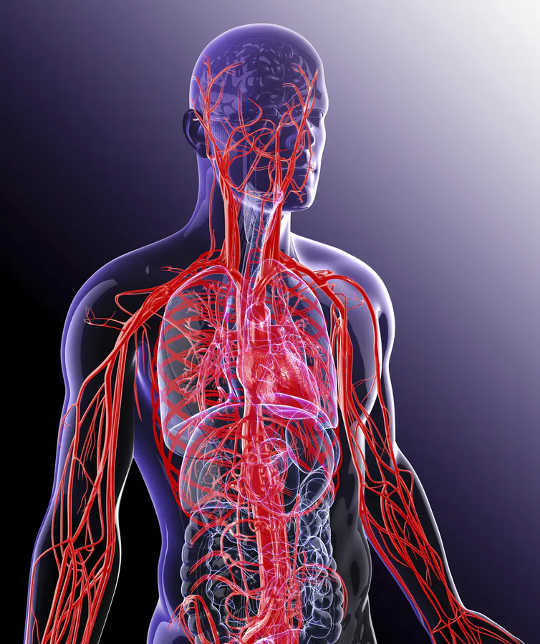
It’s no fun to exercise if you wind up doubled over with gastrointestinal problems. Goads Agency/iStock via Getty Images Plus
You’re doing it! You’re working out, reaping all those benefits of exercise that have been drilled into your head.
So you’re pedaling your heart out or running like you’re escaping a zombie horde. You’re feeling accomplished, on cloud nine, until … your stomach starts to churn. You may even feel dizzy. Your feelings of accomplishment have turned to agony as you deal with a bout of nausea.
Exercise-induced nausea is quite common, as are exercise-induced gastrointestinal (GI) problems in general, affecting perhaps up to 90% of endurance athletes.
So why does this happen and, more important, how can you prevent it?
Get The Latest By Email
The cause: Competing demands
When you exercise, skeletal muscles in your legs and arms contract. To work most efficiently, they need oxygen. So your heart muscle contracts, too, increasing blood flow through your body. The hemoglobin molecules within your red blood cells carry oxygen to your working muscles.

Your body directs oxygen where it’s most needed by sending blood to the most active tissues. PIXOLOGICSTUDIO/Science Photo Library via Getty Images
To maximize the amount of blood being delivered to the active muscles, your body diverts blood away from inactive areas – such as your gut. This diversion is overseen by the “fight or flight” branch of your nervous system. Known as the sympathetic nervous system, it causes some blood vessels to narrow, limiting blood flow. You don’t have conscious control over this process, known as vasoconstriction.
But your contracting skeletal muscles have a special power to preserve blood flow. They’re able to resist the call for vasoconstriction that helps divert blood away from inactive areas. This resistance to the effect of the sympathetic nervous system is called “functional sympatholysis.” Physiologists like me continue to work to understand the specific mechanisms by which this can occur.
So why does limiting blood flow to the gut cause distress?
The relative ischemia, or lack of blood flow, can have different effects. It can change how cells are able to absorb what has been digested and how broken-down food moves through the gut. Taken together, the changes result in an unpleasant feeling you may know all too well.
The lack of blood flow is particularly challenging if the digestive system is actively trying to break down and absorb food, a main reason exercise-induced nausea can be worse right after you’ve eaten, especially if the pre-workout meal had a lot of fat or concentrated carbohydrates.
The cure: Moderation and modification
It’s no fun to exercise if you’re doubled over with stomach cramps or running for the bathroom. So what can you do to limit symptoms or get rid of them when they crop up?
-
Moderate your exercise intensity. Nausea is more common with high-intensity exercise, where the competing demands for blood flow are highest. Especially if you’re newer to working out, gradually increasing exercise intensity should help to minimize the likelihood of GI distress.
-
Modify your exercise. Some evidence suggests that certain exercises, like cycling, can put the body in a position that’s more likely to cause gut problems. Try different forms of exercise, or combinations of different modes to meet your fitness goals while minimizing discomfort. Be sure to properly warm up and cool down to prevent rapid changes in your body’s metabolism.
-
Modify what and when you eat and drink. Stay hydrated! You’ve probably heard it before, but drinking enough is one of the best ways to prevent GI issues during and after exercise, particularly in hot or humid environments. It is possible to overhydrate, though. Aim for about half a liter per hour of fluids, including some low-carbohydrate and low-sodium sports drinks for high-intensity exercise. It may take some experimentation with different foods and the timing of ingestion to figure out what works best for you and your training goals. You can also incorporate foods like ginger, crackers and coconut water that might help settle your stomach.

Be sure to drink up during and after your workout. Deby Suchaeri/Moment via Getty Images
The caveat: When to seek help
While exercise-induced nausea is unpleasant to deal with, in general it isn’t a major health concern. Most symptoms should resolve within an hour of finishing exercise. If problems persist either for long periods after exercise or each time you work out, it’s worth having a conversation with your doctor.
Sometimes the GI distress during or after exercise can actually lead to vomiting. If you unfortunately do throw up, you’ll likely feel better but will also need to rehydrate and replenish the nutrition you lost.
If you’re looking to start an exercise regimen or up the intensity of your current workouts, seeking the advice of trained professionals who can tailor a plan to your needs is often a smart approach. Exercise physiologists or certified personal trainers can provide exercise programming of appropriate intensity, and registered dietitian nutritionists can discuss individual nutritional needs and strategies. Your primary care provider can help to screen for more serious medical issues and should be informed of your exercise routine as well.
About the Author
Anne R. Crecelius, Associate Professor of Health and Sport Science, University of Dayton
This article is republished from The Conversation under a Creative Commons license. Read the original article.
books_exercise









